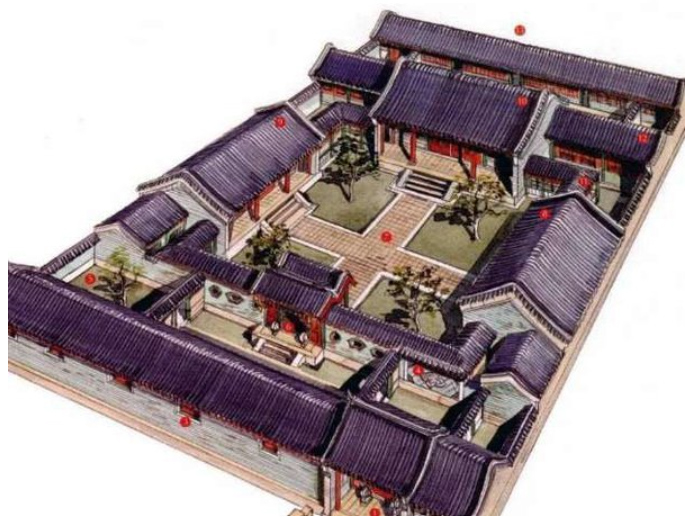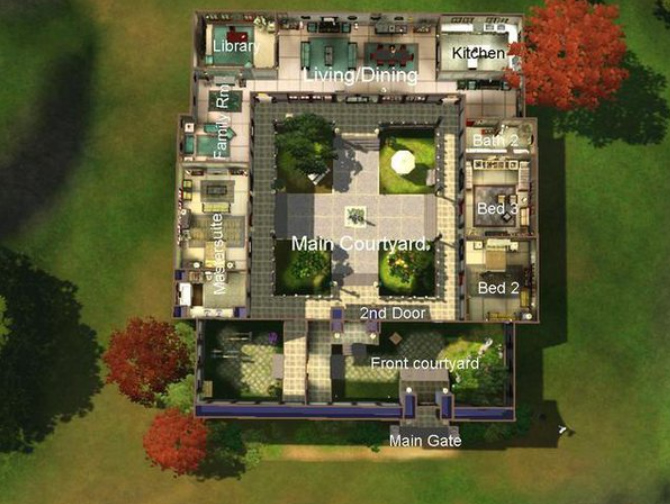 网友提问:中国人还想建造自己的传统建筑吗?
网友提问:中国人还想建造自己的传统建筑吗?
Do Chinese people still want to build their traditional architecture?
译文简介
如果你指的是像紫禁城这样的建筑,可能没有人会这么做。但最新的传统民居,四合院,在中国仍然很受欢迎。
正文翻译
Depending on which “tradition” you are talking about.
这取决于你谈论的是哪种“传统”。
这取决于你谈论的是哪种“传统”。
If you mean the architecture like Forbidden Palace, probably no one would do that. You don’t want a kitchen 2 miles away from your dining hall. That’s emperor’s life. Not much people are used to that.
如果你指的是像紫禁城这样的建筑,可能没有人会这么做。你不会希望厨房离你的食堂两英里远。这就是皇帝的生活。没有多少人习惯这样。
如果你指的是像紫禁城这样的建筑,可能没有人会这么做。你不会希望厨房离你的食堂两英里远。这就是皇帝的生活。没有多少人习惯这样。
But the most recent traditional civilian residence, Siheyuan, is still very popular in China.
但最新的传统民居,四合院,在中国仍然很受欢迎。
但最新的传统民居,四合院,在中国仍然很受欢迎。

Siheyuan’s design is featured by a courtyard surrounded by independent houses. The design emphasize on security, privacy and efficient usage of land resource. From outside, the pass by can only see a brick wall. The courtyard in the middle provided ambience for family communication and enough lighting for all houses.
四合院的设计特点是一个由独立房屋包围的庭院。该设计强调土地资源的安全、隐私和有效利用。从外面看,路过的人只能看到一堵砖墙。中间的庭院为家庭交流提供了环境,并为所有房屋提供了充足的照明。

Usually, this is a big structure for all family members. Each small family then have an independent house. All family members share the same yard and outer wall. This is a very reasonable design for big families with multiple couples.
通常,这是适用于所有家庭成员的一个大型结构。每个小家庭都有一个独立的房子。所有家庭成员共享同一个院子和外墙。对于有多对夫妇的大家庭来说,这是一个非常合理的设计。
It is still very popular now. A siheyuan in Beijing can sell up to 100 million USD. I myself prefer living in a siheyuan, if I could afford…which unfortunately I couldn't…
它现在仍然很受欢迎。北京的四合院可以卖到1亿美元。我自己更喜欢住在四合院,如果我负担得起的话...不幸的是我负担不起...
它现在仍然很受欢迎。北京的四合院可以卖到1亿美元。我自己更喜欢住在四合院,如果我负担得起的话...不幸的是我负担不起...
评论翻译
很赞 ( 6 )
收藏
An introverts dream, I can see myself planting coffee in the gardens, taking a break at the main courtyard while sipping coffee, browsing the internet, while keeping an eye out of the younguns in the family running about.
Very practical design for those who value familial privacy, in a crowded town. Your own personal space.
一个内向者的梦想,我可以看到自己在花园里种咖啡,在主庭院休息,一边喝咖啡,一边浏览互联网,同时注意家里四处乱跑的年轻人。
非常实用的设计,适合那些在拥挤的城镇中重视家庭隐私的人。你自己的私人空间。
You just made me wish I could afford one
你刚刚让我希望我能负担得起一个。
Living with all your family and relatives? I guess introverts' dreams vary…
和你所有的家人和亲戚住在一起?我想内向的人的梦想各不相同……
I hear you, I build something like this, node units with connecting walkways. I like having dinner with the family, but dislike the bounds that extrovert family members cross all the time.
I understand extrovert nature to be “helpful" … it grinds on poor introverts like me who value his personal space, this eventually gave birth to my toolshed which I now spend quite a bit of time in.
So a shared courtyard works out if you can sit down and sip tea or coffee quietly. However once the extrovert family members come in, it's time to take a bow for quieter living space.
I get extrovert family members might feel offended by my behavior. Which happens all the time, but we're kind of made differently. It is what it is.
我明白你的感受,我也建造了类似的东西,节点单元之间有连接的步道。我喜欢和家人一起吃饭,但不喜欢那些外向的家庭成员经常越界的行为。
我理解外向性格是“有帮助的”...这会让像我这样珍视个人空间的内向者受到打击,这最终孕育了我现在花了很多时间的工具室。
所以共享庭院很不错,如果你可以安静地坐下来喝茶或咖啡的话。但是一旦外向的家庭成员进来了,就是时候退居更为安静的生活空间了。
我知道外向的家庭成员可能会因为我的行为感到受到冒犯。这种情况经常发生,但我们被塑造得有点儿不同。事实就是如此。
I like this because the noise from the yard won’t annoy the neighbors as it’s blocked by surrounding buildings. Very smart design.
我喜欢这样,因为院子里的噪音不会打扰邻居,因为它被周围的建筑挡住了。非常聪明的设计。
Or the other way around, I know a hospital with inside courtyard, it was so quiet and relaxing even though pretty busy and a lot of noise outside.
或者反过来,我知道一家有内部庭院的医院,尽管外面很忙而且很吵,但它是如此安静和放松。
100 million usd …
I dont think the design is affordable unless you change to American style living
Staying in suburban areas and driving work
1亿美元…
我认为这种设计是负担不起的,除非你转变成美国式的生活方式
住在郊区,开车上班
I don’t think the design matters much. It’s the location and the actual ownership of the land. Beijing has a special treatment for houses built before 1949, the owner of such a house owns the land as well.
我认为设计不太重要。这是土地的位置和实际所有权。北京对1949年以前建造的房屋有特殊待遇,这样的房子的主人也拥有土地。
原创翻译:龙腾网 http://www.ltaaa.cn 转载请注明出处
The 100million if I was not wrong owned by I think an Italian. Totally refurbished and improved. If I was not wrong, there is a swimming pool and underground carpark.
如果我没记错的话,那栋1亿美元的房屋所有者是一个意大利人。房子全面翻新和改进了。 如果我没记错的话,那里还有游泳池和地下停车场。
To be clear, siheyuan represents Chinese historic housing as much as Art Deco mansions represent traditional American residence. Only the very elites of Chinese society lived like that. Some of these Chinese elites got so wealthy that many Chinese dynasties had laws against owning a mansion with more rooms than the imperial palace. It was an extremely serious offence.
需要明确的是,四合院代表了中国的历史建筑,就像装饰艺术风格的豪宅代表了传统的美国住宅一样。只有中国社会最高水平的精英阶层才能过着那样的生活。这些中国精英中的一些人变得如此富有,以至于许多中国朝代都有法律禁止拥有比皇宫更多房间的豪宅。这是极其严重的罪行。
原创翻译:龙腾网 http://www.ltaaa.cn 转载请注明出处
"Only the very elites of Chinese society lived like that"
Completely false.
Plenty ordinary citizens live in siheyuan. Heck, there are about 5+ people I know in Toronto grew up in siheyuan when to were young. They were nowhere near “the very elite”.
“只有中国社会最高水平的精英阶层才能过上那样的生活”
完全错误。
许多普通市民住在四合院里。见鬼,我在多伦多认识的大约有5个以上的人,他们小时候在四合院长大。他们离“最高水平的精英阶层”相去甚远。
Looking at a research paper that studied real estate transactions in Beijing during 17–19th century. In Beijing - easily one of the richest city in China during the period, had just 6% of houses that were full silheyuan with 4 court yards - mostly located in inner city. Another 26% of the houses had at least two court yards - half silheyuan. That’s 32% of the houses in Beijing, so it was common building type if you lived in Beijing. The thing is Beijing was a very wealthy city, which is why 85% of the population was Manchus - ruling ethnic group that compose just 4% of Chinese population. Average price of home in Beijing was 492 taels of silver and for silheyuan with 4 court yards, it was 1300 - 7631 taels.
Let me put it in relative economic terms so you may understand value here. A tael of silver converts to 1000 copper yuan by gov’t mandate - actually exchange rate was much higher in favor of silver. A rich commoner during Qing earned 3000 coppers a year, that’s 3 taels at a very favorable exchange rate. This means a well-off middle class person in China would have to work for 100 years to afford a house in Beijing. Equivalent to roughly 7 million RMB today, and to afford silheyuan, one would need modern equivalent of 30 million RMB. Most expensive silheyuan costs $25.5mm USD. If you consider that this is pre-industrial era dominated by labor intensive jobs with zero financing options - a tiny fraction of 1% of Chinese population would have been able to afford such price.
so, I’d have no problem calling people who can afford these houses “very elite” even in modern day United States, let alone pre-modern China.
看一篇研究17 - 19世纪北京房地产交易的论文。在北京——这一时期中国最富有的城市之一,只有6%的房子是四合院式的——大部分位于内城。另外26%的房子至少有两个院子——半四合院(只有一半院落)。这些是北京32%的房子,所以如果你住在北京,这是很常见的建筑类型。问题是北京是一个非常富裕的城市,这就是为什么85%的人口是满族人——占中国人口4%的统治民族。北京住宅均价为492两白银,四合院四合院均价为1300 - 7631两白银。
让我用相对经济的术语来解释,这样你就能理解这里的价值了。根据政府的规定,1两白银可以兑换1000铜币——实际上汇率要高得多,有利于白银。清朝时,一个富有的平民一年挣3000铜币,按非常有利的汇率算,就是3两。这意味着,在中国,一个富裕的中产阶级要工作100年才能在北京买得起一套房子。相当于今天的大约700万元人民币,而要买得起四合院,需要相当于现在的3000万元人民币。最贵的四合院价值2550万美元。如果你考虑到这是前工业化时代,劳动密集型工作占主导地位,没有融资选择,那么1%的中国人口中的一小部分才能够负担得起这样的价格。
所以,即使在现代的美国,我也可以毫不犹豫地称买得起这些房子的人为“最高水平的精英阶层”,更不用说前现代的中国了。
Where are your facts?
Did you not read that my personal experience is basically a counter-argument? Granted it is anecdotal, but since your statement was an absolute claim (only “very elite" can have those houses), it is enough to serve as counter-argument.
I think the issue here is that, there are a lot of “ordiny” siheyuan, not just what's in the screenshot of the answer. The word “siheyuan” is used much more broadly than that. And this is coming from someone grew up in Beijing.
你的事实在哪里?
你没读到我的个人经历基本上是一个反论点吗?虽然这是轶事,但由于你的陈述是绝对的主张(只有“最高水平的精英阶层”才能拥有这些房子),这足以作为反驳。
我认为这里的问题在于,不仅仅是回答截图中所展示的那种的四合院,还有很多普通的四合院。“四合院”一词的使用范围要广泛得多。这是一个在北京长大的人说的。
Statistically speaking, there’s an extremely low chance that all your five random friends lived in Beijing during the time where 85% of the population was Manchus and Qing government officials - where owning proper silheyuan would not only require large amount of money, but many servants to just maintain.
Or it could be after Boxer’s rebellion and 1911 revolution ,property price in Beijing plummeted and even people with average income had chance to live in Beijing. But, that’s like living in an abandoned mansion in Detroit and calling it affordable.
从统计学上讲,你随机挑选的五个朋友都生活在北京的可能性极低,北京当时85%的人口是满族和清政府官员,拥有合适的四合院不仅需要大量的钱,还需要许多仆人来维持。也可能是在义和团起义和辛亥革命之后,北京的房价暴跌,即使是一般收入的人也有机会住在北京。但是,这就像住在底特律一座废弃的豪宅里,还说他负担得起一样。
But those Siheyuan in other provinces, other cities, other towns, are also Siheyuan. As average person, I grow up in a Siheyuan of 7 bedrooms. All my neighbors live in Siheyuan that was built in the 80s by the peasants. One family, one Siheyuan.
It’s just one of the traditional house structure in the north !!!
但那些外省、外市、外镇的四合院,也都是四合院。作为一个普通人,我在一个有7间卧室的四合院长大。我所有的邻居都住在四合院,四合院是80年代农民建的。一个家庭,一个四合院。
这只是北方的一种传统房屋结构!!
These old houses usually have terrible infrastructure, like plumbing and electrical stuff. Also, don't expect you could park your car anywhere near your house.
这些老房子的基础设施通常很差,比如管道和电气设备。另外,别指望你能把车停在你家附近。
If you had 100 million yuan to splash on this, you can afford refurbishment.
如果你有1亿元,你就能负担得起翻新。
Two wealthy familly i know have this kind of house.. so that patriarch can see grandchild quite often without being in one roof
Didn’t work for them, the children prefer live some distance away
我认识的两个富有的家庭都有这种房子。这样一来,族长就可以经常见到孙子孙女,而不用住在同一个屋檐下
但对他们(孩子)来说不合适,孩子们喜欢住得远一点
The two examples that you showed are definitely for rich people, even in ancient times. But generally, my parents’ generation do love that, especially the space for gardening. But if you try to build new ones in modern city (unless the old town), people from nearby taller buildings can clearly watch what you are doing….
你展示的两个例子无疑是给富人住的,即使在古代也是如此。但总的来说,我父母那一代人非常喜欢四合院,特别是喜欢园艺的空间。但如果你在现代城市(除非是旧城区)建造新的四合院,附近高楼里的人可以清晰地看到你在做什么。
原创翻译:龙腾网 http://www.ltaaa.cn 转载请注明出处
From your answer it is unclear if this was (is) multi or single family dwelling? The flooorplan is for a single family, whilst you suggest there were different families in the houses around the atrium.
从您的回答中,不清楚这是单户还是多户住宅?这个平面图是单户住宅的,而您暗示周围的房子有不同的家庭。
原创翻译:龙腾网 http://www.ltaaa.cn 转载请注明出处
Traditionally, married sons won’t leave their family. Instead, bride will join this big family. So it will be a big family with multiple couples. And each couple will need independent bedrooms but share common space like kitchen and courtyard. But this design isn’t absolute. Siheyuan can easily be transformed to serve modern families. The idea is middle courtyard surrounded by independent houses. As in Chinese, siheyuan means surrounded yard.
传统上,已婚的儿子是不会离开家的。相反,新娘将加入这个大家庭。所以这将是一个由多对夫妇组成的大家庭。每对夫妇都需要独立的卧室,但共用厨房和庭院等公共空间。但这种设计并不是绝对的。四合院可以很容易地改造以为现代家庭服务。核心理念是由独立房屋包围的中间庭院。在汉语中,四合院的意思是被环绕的庭院。